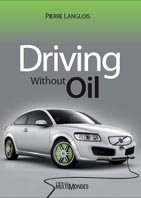
Illustration - Graphic showing decreases in fuel consumption of an advanced hybrid car, compared to a conventional car today that consumes 100 units of fuel for a given distance.
For those who have read my previous notes, you know that for me the Car of Tomorrow (2030) is a plug-in hybrid. In what follows, you will see that when this car will run in fuel mode, after having exhausted its available electrical energy from the battery, the car of tomorrow will consume 4 times less fuel, on average, than conventional cars today. For the coming paragraphs, please refer to the chart above.
First, experts agree that a robust good hybridation with a central electric motor can reduce fuel consumption by one third. To do this, we have to use high power Li-ion batteries whose efficiency reached over 98%, and high efficiency electric motors as well (some reach 96% today). For comparison, Ni-MH batteries, such as the ones in the Prius, have an efficiency of approximately 75%.
In a second step, we can further decrease by one third the fuel consumption of hybrid cars by improving their fuel engine through the use of various technologies. The table below lists several. The first three (in orange) are quite independent of each other and together can provide a reduction in consumption approaching 25%. The other technologies listed, all contribute to a better combustion and cannot simply be added as they are in competition one with another. I will give more information on some of these technologies in future posts, but for impatient readers you can always consult my last book «Rouler sans pétrole» (Driving without oil), where you will find details and references. Also, remember that the mere fact of moving from a gasoline engine to a diesel engine reduces the consumption by around 20%.

In addition to the many improvements that can be brought to piston engines, the plug-in hybrid car of Tomorrow is an extraordinary opportunity to try new types of rotary engines more energy efficient, as potentially the Quasiturbine invented by Gilles Saint-Hilaire, or the Radmax engine from Reg / Regi Technologies. The idea is that these engines will be used at most 80 000 km (50,000 miles) on the life of the car, since the majority of the mileage will be driven with electricity. The constraint of durability is much less severe. Moreover, these rotary engines are about 4 times lighter and more compact than piston engines, with far fewer moving parts. They should thus be cheaper. Such engines would operate as a generator to recharge the battery without being connected mechanically to the wheels.

Illustration - 3D representation of the different components of a Quasiturbine with carriage, invented by Canadian physicist Gilles Saint-Hilaire.
Now, continuing our quest for the reduction of fuel consumption, if we refer again to the graph at the beginning, we see that we can reduce consumption by 25% more if we play on the car's weight, aerodynamics and tires. A realistic weigh reduction of 30% is accompanied by a decrease in consumption of around 18%. To achieve the 25% reduction in consumption of our car, we can also use low-rolling resistance tires that bring the fuel consumption down by 2% to 5%. The remaining of the 25% is obtained by implementing a better aerodynamic profile for the car.
At this point, we have an advanced plug-in hybrid car with a central electric motor, that consumes 3 times less fuel than a traditional car today, when operating in fuel mode.
The last step in our scenario to reduce consumption is to equip our plug-in hybrid car with 4 wheel-motors. These motors give an additional 25% of fuel consumption reduction in mixed driving, as we have seen in the previous note on wheel-motors. The result is, ultimately, a reduction of fuel consumption by a factor of 4 mentioned in the title of this post. The consumption of an intermediate advanced hybrid car would thus be 2 to 2.5 litres/100 km (fuel economy of 95-115 mpg).
Furthermore, if plug-in hybrid cars make 80% of their mileage with electricity, these cars will consume 20% ÷ 4 = 5% of the fuel used by cars today, that is 20 times less in a year! With small amounts like that we can envision without any trouble a sustainable development of second generation biofuels, made from waste, residues and non-food plants. We will learn more on this topic in later notes.





i am lucky also an green person and would like to say your doing a good job
ReplyDeleteregards_krumptonic _____________-________________
Thank you very much for writing such an interesting article on this topic. This has really made me think and I hope to read more. Fuel Off Road Wheels
ReplyDelete